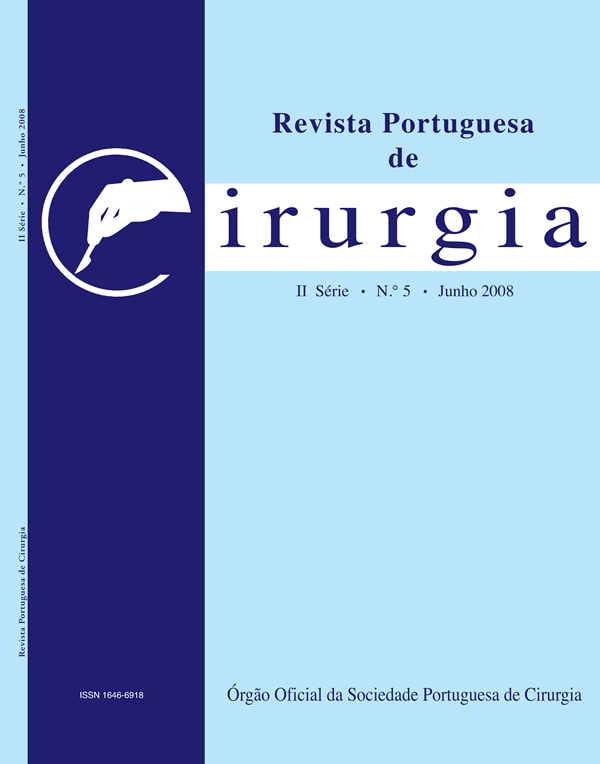M.E.L.D. in surgical risk evaluation of cirrhotic patients - Preliminary analysis of 98 cases - M.E.L.D. in surgical risk evaluation
Abstract
Introduction: Hepatic cirrhosis is a recognized surgical risk factor. Recent studies suggested that M.E.L.D. (Model for End-Stage Liver Disease) may represent a promising alternative to Child-Turcotte-Pugh classification as a predictive factor of operative mortality and morbidity; incorporation of serum sodium and age (iM.E.L.D.) seems to improve its prognostic potential.
Objectives: To evaluate the utility of M.E.L.D. and iM.E.L.D. in the quantification of surgical risk of cirrhotic patients and to compare its prognostic value with the Child-Turcotte-Pugh classification.
Material and methods: A retrospective study of 98 cirrhotic patients operated, in our department, between 1998 and 2007 was undertaken. Results: Forty nine per cent of the patients were included in A class of Child-Turcotte-Pugh; mean M.E.L.D. score was 7,5±2,6 (1,6- 15,2) and mean iM.E.L.D. score was 31,5±6,1 (16,8-46,3). Mortality and morbidity rates were 11% and 29%, respectively. iM.E.L.D. represented a significant prognostic factor of mortality (auR.O.C.=82%, 70,7-94,1; p=0,001) with a better predictive potential than M.E.L.D. (auR.O.C.=66%, 46,6-85,5; p=0,048) and Child-Turcotte-Pugh classification (auR.O.C.=62%, 40-84,5; p=0,037). iM.E.L.D. score was superior in cases of mortality (37,7±5,6 versus 30,5±5,6; p=0,0001); the operative death probability was 3,6% (2,9- 4,4) in patients with a score inferior or equal to 31, 16% (13-19) between 32 e 38 and 49,5% (37,9-61,7) when superior or equal to 39. M.E.L.D. was related with mortality as a discontinuous variable: score superior or equal to 12 were associated with a mortality rate of 50% (versus 8,8%; p=0,002; odds ratio=7,4; IC 95% 2,8-19,2), with a better accuracy than Child-Turcotte-Pugh classification (89,7 versus 85,6%).
Conclusions: In this study, iM.E.L.D. and M.E.L.D. scores (that one used for the first time in the perioperative context) revealed to be excellent predictive parameters of operative mortality and morbidity in cirrhotic patients, with good correlation and accuracy superior to Child-Turcotte-Pugh classification; they also showed better discriminative capacity, objectivity and reproducibility. And if our results are confirmed in further studies, they will have a major interest in surgical risk evaluation of patients with chronic hepatic diseases.
Keywords: Surgical risk, cirrhosis, Meld, iMeld, Child-Turcotte-Pugh
Downloads
Downloads
Published
Issue
Section
License
Para permitir ao editor a disseminação do trabalho do(s) autor(es) na sua máxima extensão, o(s) autor(es) deverá(ão) assinar uma Declaração de Cedência dos Direitos de Propriedade (Copyright). O acordo de transferência, (Transfer Agreement), transfere a propriedade do artigo do(s) autor(es) para a Sociedade Portuguesa de Cirurgia.
Se o artigo contiver extractos (incluindo ilustrações) de, ou for baseado no todo ou em parte em outros trabalhos com copyright (incluindo, para evitar dúvidas, material de fontes online ou de intranet), o(s) autor(es) tem(êm) de obter, dos proprietários dos respectivos copyrights, autorização escrita para reprodução desses extractos do(s) artigo(s) em todos os territórios e edições e em todos os meios de expressão e línguas. Todas os formulários de autorização devem ser fornecidos aos editores quando da entrega do artigo.



